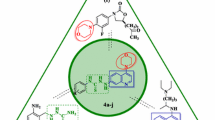Abstract
Investigation of derivatization of primaquine (1) with various perfluoroacylating reagents revealed that the quinoline ring portion of the drug undergoes unexpectedly facile acylation. Chemical and spectral evidence in support of the assigned structures is presented and discussed. Results of the evaluation of these new primaquine derivatives for antimalarial activity is reported.
Similar content being viewed by others
References
McChesney J. D., Sarangan S. (1984) Pharm. Res. 184–186.
Clark A. M., Evans S. L., Hufford C. D., McChesney J. D. (1982) J. Nat. Prod. 45, 574–581.
Clark A. M., Hufford C. D., Gupta R. C., Puri R. K., MyChesney J. D. (1984) Appl. Environ. Micro. 47, 537–539.
Raj Gopalan T. G., Anjaneyulu B., Shanbag V. D., Grewal R. S. (1981) J. Chromatogr. 224, 265–273.
Clark A. M., Hufford C. D., McChesney J. D. (1981) Antimicrob. Ag. Chemother. 19, 337–341.
Author information
Authors and Affiliations
Rights and permissions
About this article
Cite this article
McChesney, J.D., Gupta, R.C. Chemistry of Primaquine I: Acylation of the Quinoline Ring Portion. Pharm Res 2, 46–49 (1985). https://doi.org/10.1023/A:1016322207691
Issue Date:
DOI: https://doi.org/10.1023/A:1016322207691



